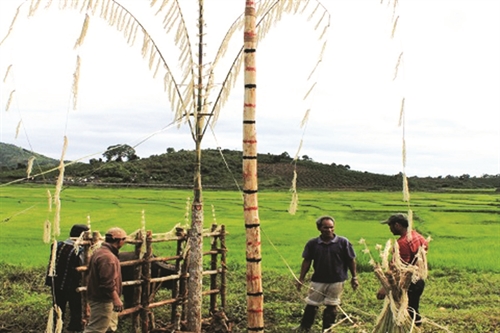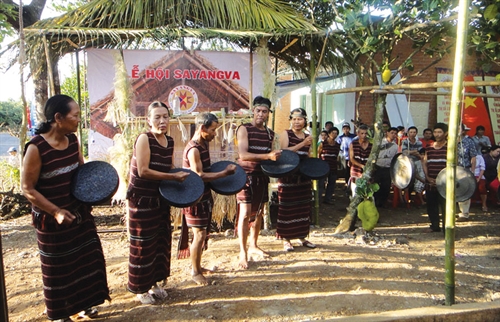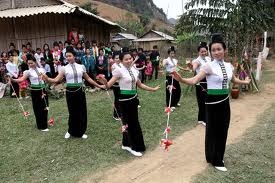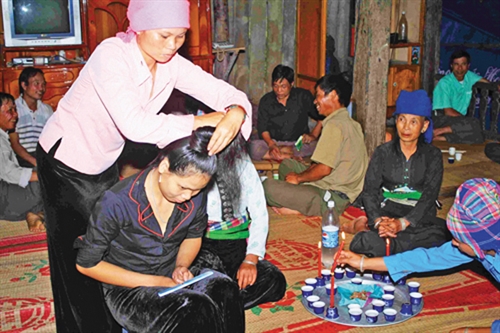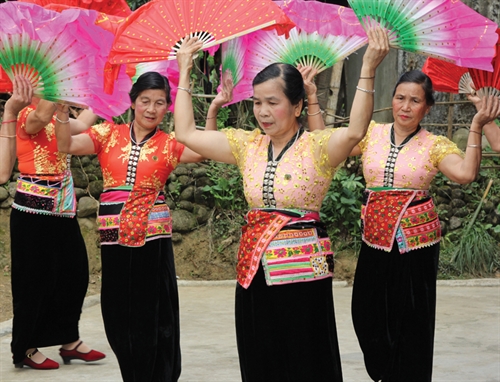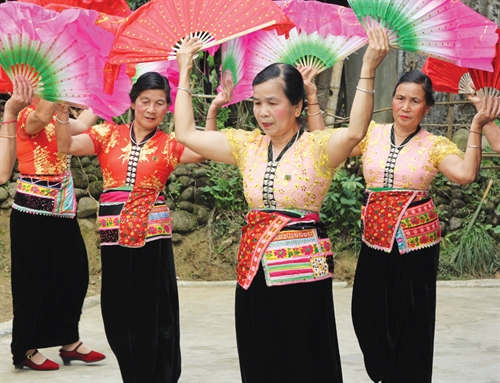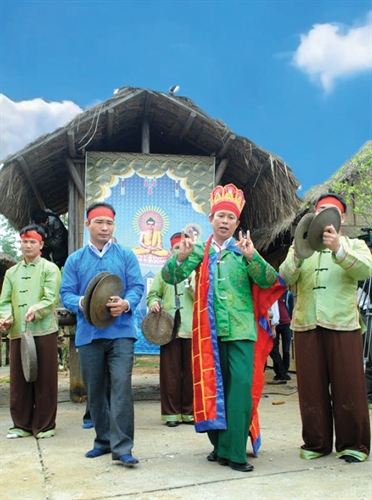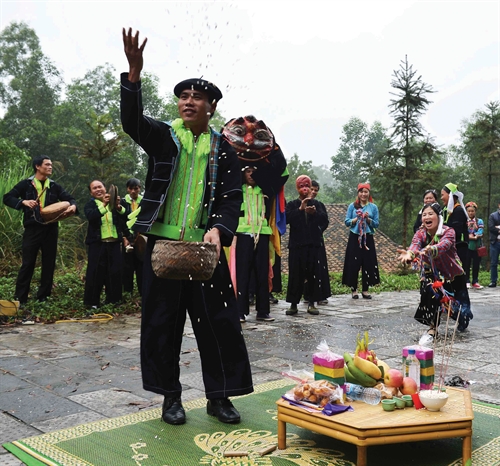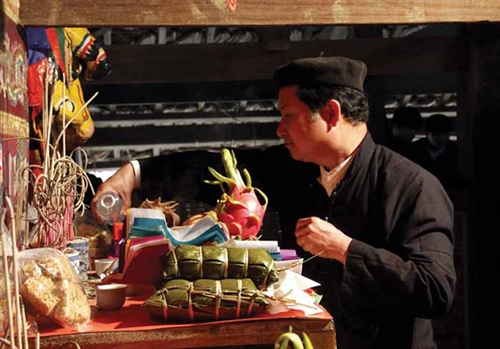Ta Thi Tam
Ethnology Institute
Whenever spring comes, all Nung ethnic people feel excited in the boisterous atmosphere of lion dance.
The lion dance of the Nung, which is believed to originate from Chinese lion dance in which performers mimic a lion’s movements in a lion costume, reflects the courage and nature-conquering process of the group. It also expresses their wish for bumper crops, prosperity and happiness in the new year.
The lion dance is performed at the village temple - the holy place where Tho Cong (the Land Genie) is worshiped, at villagers’ houses to welcome the New Year; and at the traditional Long Tong (Going to the Rice Field) festival.
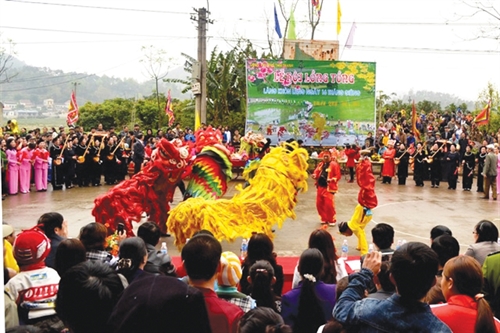 |
Lion dance in a spring festival of the Nung ethnic group in Lang Son province__Photo: Internet |
Lion dance at the village temple
Every village of the Nung has a small, simple temple which was built as soon as they choose the land to establish their village.
Before performing the dance, the lion must visit Tho Cong to ask for his permission. According to the Nung, without doing this, they will be punished. A lion dance at the village temple consists of two parts:
Part one (the dance in front of the temple): When arriving at the temple, the lion dances with its head held high then low, expressing its joy to visit and say New Year greetings to the deities. Next, the lion dances with quick and energetic movements to salute villagers surrounding it. Then, it comes to dance in front of the temple with slow movements, bowing down before the two joss stick bowls on both sides of the temple door to ask for Tho Cong’s permission to enter the temple.
After bowing down to Tho Cong, the lion gradually steps backward to the door as turning one’s back to Tho Cong’s altar is a taboo for the Nung. Passing through the temple door, the lion kowtows to the genie three times and salute the villagers in the fast and continuous sounds of drums, gongs and cymbals to finish the dance.
Part two (the dance inside the temple, kowtowing to Tho Cong): Before the lion enters the temple, the drums, gongs and cymbals are beaten fast and continuously while the lion dances swiftly and vigorously to the music.
After entering the temple, the lion dances to salute and kowtows to Tho Cong. When performing such dance, the lion lowers its head and bends down, sometimes moves with its elbow leaning against the ground from left to right, then walks backward. After the dance, it is given a cup of liquor, a tip and lucky money by the village chief who must in turn perform some martial art movements.
The lion dance at the village temple demonstrates the Nung’s veneration for deities and their belief in the protection by the supernatural forces.
New-year lion dance at villagers’ houses
During Tet (Lunar New Year) festival, the Nung people usually invite lion dance teams in their village to perform at their own houses on the first or second day of Tet, depending on different localities, as the appearance of the lion is believed to chase away evil spirits and epidemics and bring luck, peace and prosperity in the new year. The lion dance here is composed of two main parts:
Dance outside the house (on the front yard: The lion dances in the yard then moves to the door and kowtows to Tho Cong from afar. With slow movements, the lion dances to ask for the house masters’ and their ancestors’ permission. Next, it licks both doors or gate posts, which are thought to be clung with evil spirits, in order to dispel them. After the in-house dance, the lion quickly walks back out of the house to the fast and continuous sounds of gongs, drums and cymbals. In particular, when going into or out of the house, the lion is not supposed to stand for a while in the middle of the door; if doing so, it will block the good luck from entering the house.
Dance inside the house: After entering the house to say New Year greetings, the lion licks two pillars of the house, kowtows three times in front of the ancestor altar, then licks the altar. The lion is often given lucky money, liquor and a tip by the house master who performs some martial art moves to thank the lion. After that, the lion stoops down and steps back slowly and gently without turning its back to the altar; if turning its back, it will be punished by the house master’s ancestors.
Yet, some families only allow the lion to dance on their front yard as their ancestors fear lions.
Lion dance and martial art performances at Long Tong festival
Lion dance and martial art performance are part and parcel of Long Tong festival, a typical cultural event of the Nung. At this festival, lion teams from neighboring villages are invited to perform and compete with one another. The lion dance is divided into five parts.
The first is the dance to welcome guest lions: When a guest lion arrives, it will be greeted by the host lion. The two lions then dance together lithely, prancing high now and kneeling down then in tune with the gong sounds and drum beats. They seem to play with each other but actually compete in martial art skills in the dance, waiting for an opportunity to knock down the opponent. To end the dance, the lions walk lithely around to salute their spectators.
The second is the dance to greet deities: This dance is compulsory and lasts for about half an hour. When the gongs and drums resound loudly, all the lions start dancing in sync with heads held high, turning right then turning left then bending down.
The third is the festive dance: In this dance, the lion dance teams demonstrate their talents and skills adapted from traditional martial art exercises. The members of each team perform martial art movements and approach the lion to tie a pink fabric ribbon to its chin which symbolizes its beard.
The lion dancers perform for about an hour until a “Bao dong” (a person masquerading as an orang-outang) joins. “Bao dong” often uses a tree branch to bully the lion or chases after the lion and treads on its neck which makes the lion angry and fight back. All these performances bring amusements and laughs to the audience. Out of the blue, monkeys (persons wearing a monkey mask), often two from each team, jump onto the stage to join the performance with martial art movements. “Bao dong” and monkeys then tease the lion while the lion pounces on and tries to grab them but in vain as “Bao dong” and monkeys swiftly dodge the lion’s attacks and fight back with martial art skills. It is these lively martial-art performances that make the lion dance festival attract a lot of spectators.
The fourth is the birth-giving lion dance: Appearing on the scene are lions caressing each other, then a little lion (a person wearing a little lion head) creeps behind a mother lion’s tail. The mother lion then trudges pantingly as if she is pregnant. Then a baby lion is born and its mother shows fondly acts, caresses her baby and teaches its first dance steps. Finally both the mother and baby lions dance together lithely, expressing the growth of the baby lion.
The fifth is the lion-hunting dance: A lion dance team member acts as the hunter holding a short sword and “Bao dong” and monkeys jointly chase after the lion around the yard to the quick and continuous sounds of gongs, drums and cymbals and the cheers from spectators. With swift and vigorous martial art movements, the lion dodges the attacks and pounces on the prey. But in the end it is lured into a trap and killed by the hunters. The dance demonstrates the Nung’s power to conquer the nature. With their strength, skills and intelligence, they can subdue the lion known as the king of the jungle.
The lion dance is followed by martial art performances with bare hands and weapons such as sticks, short swords and slam sla (tridents). The bare-hand martial art dance is performed in tune with the music of gongs, drums and cymbals to salute deities. The martial art dance with sticks is performed by martial artists who attack one another with precise and safe movements. The short-sword dance can be performed in single or couple, demonstrating fast, beautiful and lithe movements. Meanwhile, the slam sla dance is merely a martial art type with swift and flexible acrobatic moves greatly admired by the audience.-
